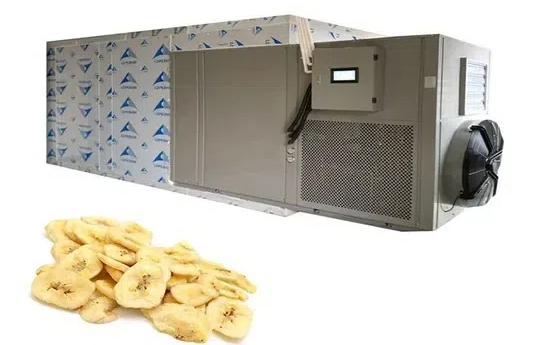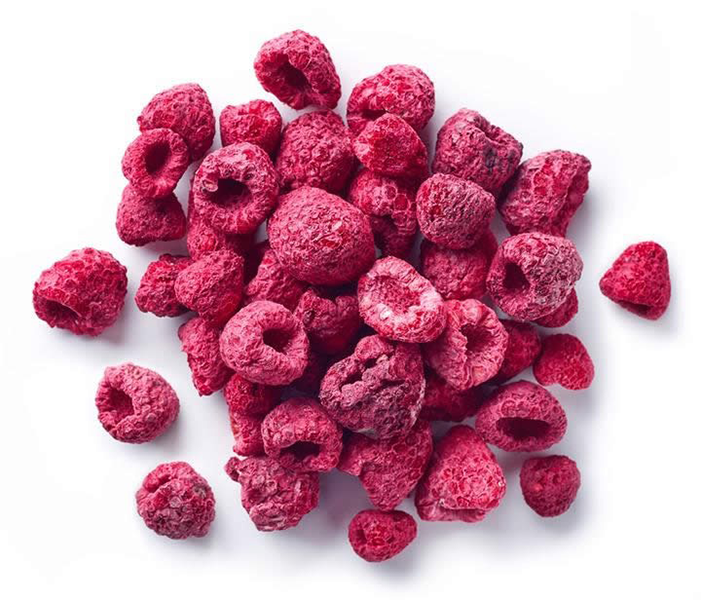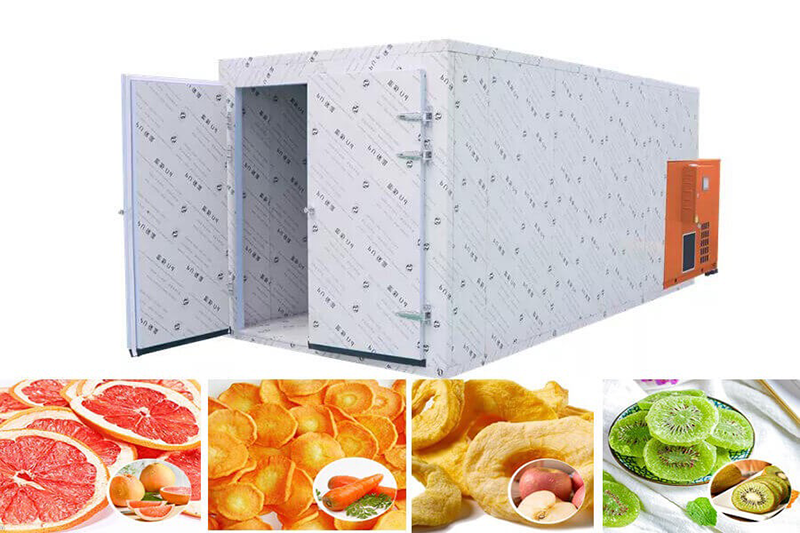
Content Menu
● What Are Room Type Drying Machines?
● How Do Room Type Drying Machines Work?
● Benefits of Room Type Drying Machines
>> 1. Extended Shelf Life
>> 2. Nutrient Retention
>> 3. Cost-Effective Preservation
>> 4. Versatility
>> 5. Consistent Quality
● Types of Room Type Drying Machines
>> 1. Heat Pump Food Dehydrator Room
>> 2. Mesh Belt Food Dehydrator
>> 3. All-in-One Food Dehydrator
>> 4. Microwave Food Dehydrator
● Choosing the Right Room Type Drying Machine
● Best Practices for Using Room Type Drying Machines
● Applications of Room Type Drying Machines
● Advancements in Room Type Drying Machine Technology
>> 1. Smart Controls and IoT Integration
>> 2. Improved Energy Efficiency
>> 3. Multi-Stage Drying Processes
>> 4. Enhanced Sanitization Features
● Environmental Impact and Sustainability
● Future Trends in Room Type Drying Machines
● Conclusion
● Frequently Asked Questions
>> 1. How long does it take to dry food in a room type drying machine?
>> 2. Can all foods be dried in a room type drying machine?
>> 3. How do I clean and maintain my room type drying machine?
>> 4. Is it safe to leave a room type drying machine running overnight?
>> 5. How do I store dried foods, and how long will they last?
● Citations:
Room type drying machines, also known as food dehydrators, have revolutionized the way we preserve and process food. These versatile appliances offer numerous benefits for both commercial and home use. In this comprehensive guide, we'll explore the ins and outs of room type drying machines, their working principles, advantages, and address some frequently asked questions.

What Are Room Type Drying Machines?
Room type drying machines are specialized equipment designed to remove moisture from various food products. These machines create a controlled environment where temperature, humidity, and airflow are carefully regulated to achieve optimal drying results. Unlike traditional drying methods, room type drying machines offer consistency, efficiency, and superior quality in food preservation.
How Do Room Type Drying Machines Work?
The working principle of room type drying machines is based on the controlled evaporation of moisture from food products. Here's a breakdown of the process:
1. Hot Air Circulation: The machine is equipped with a heating element and a fan that generates and circulates hot air throughout the drying chamber.
2. Temperature Control: Most room type drying machines feature adjustable temperature settings, typically ranging from 95°F to 165°F (35°C to 74°C), allowing users to select the appropriate temperature for different types of food.
3. Humidity Regulation: As the hot air circulates, it absorbs moisture from the food products, gradually reducing the overall humidity within the drying chamber.
4. Airflow Management: The design of room type drying machines ensures even distribution of hot air across all trays or racks, promoting uniform drying.
5. Moisture Extraction: The moist air is then expelled from the chamber, either through an exhaust system or by natural convection, depending on the machine's design.
Benefits of Room Type Drying Machines
1. Extended Shelf Life
One of the primary advantages of using room type drying machines is the significant extension of food shelf life. By removing moisture, these machines inhibit the growth of bacteria, yeast, and mold, allowing dried foods to be stored for months or even years.
2. Nutrient Retention
Unlike some preservation methods that can degrade nutritional value, room type drying machines help retain essential vitamins and minerals in food products. The low-temperature drying process preserves most of the nutrients, resulting in healthier dried foods.
3. Cost-Effective Preservation
Investing in a room type drying machine can lead to substantial cost savings in the long run. By allowing users to buy fresh produce in bulk and preserve it for extended periods, these machines reduce food waste and the need for frequent grocery shopping.
4. Versatility
Room type drying machines are incredibly versatile, capable of drying a wide variety of foods, including fruits, vegetables, herbs, meats, and even prepared meals. This versatility makes them valuable assets in both commercial and home kitchens.
5. Consistent Quality
The controlled environment provided by room type drying machines ensures consistent drying results. This is particularly important for commercial food producers who need to maintain product quality and meet industry standards.
Types of Room Type Drying Machines
There are several types of room type drying machines available in the market, each designed for specific applications and capacities:
1. Heat Pump Food Dehydrator Room
This type of drying machine uses a heat pump system to generate hot air. It's energy-efficient and provides precise temperature control, making it ideal for drying temperature-sensitive foods.
2. Mesh Belt Food Dehydrator
Mesh belt dehydrators feature a continuous drying process, where food is placed on a mesh conveyor belt that moves through different temperature zones. These machines are suitable for high-volume production and can handle various heat sources, including coal, gas, steam, or electricity.
3. All-in-One Food Dehydrator
All-in-one dehydrators are compact units that combine the drying chamber, heating element, and control system in a single appliance. These are popular for small-scale operations and home use due to their convenience and ease of operation.
4. Microwave Food Dehydrator
Microwave dehydrators use microwave energy to remove moisture from food products. While less common, these machines can offer rapid drying times for certain types of foods.
Choosing the Right Room Type Drying Machine
When selecting a room type drying machine, consider the following factors:
1. Capacity: Determine the volume of food you need to dry regularly and choose a machine that can handle your production needs.
2. Temperature Range: Ensure the machine offers a suitable temperature range for the types of food you plan to dry.
3. Energy Efficiency: Look for models with good insulation and energy-saving features to reduce operating costs.
4. Construction Quality: Opt for machines made from durable materials like stainless steel for longevity and easy cleaning.
5. Control Features: Advanced control systems with programmable settings can improve drying precision and consistency.
Best Practices for Using Room Type Drying Machines
To get the most out of your room type drying machine, follow these best practices:
1. Proper Food Preparation: Cut food into uniform sizes (typically no more than 1/4 inch thick) to ensure even drying.
2. Tray Arrangement: Arrange food items in a single layer on trays, allowing space between pieces for proper air circulation.
3. Temperature Selection: Use appropriate temperatures for different food types. For example, fruits and vegetables typically dry best between 125°F and 135°F (52°C to 57°C).
4. Rotation: If your machine doesn't have a built-in rotation system, consider rotating trays periodically for more uniform drying.
5. Monitoring: Check food regularly during the drying process, especially towards the end, to prevent over-drying.
6. Storage: Once dried, store food in airtight containers in a cool, dark place to maintain quality and extend shelf life.

Applications of Room Type Drying Machines
Room type drying machines find applications in various industries and settings:
1. Food Processing: Commercial food producers use these machines to create dried fruits, vegetables, and meats for retail sale.
2. Agriculture: Farmers and cooperatives employ drying machines to preserve excess harvest and create value-added products.
3. Restaurants and Catering: Food service businesses use dehydrators to create unique ingredients and extend the shelf life of perishables.
4. Home Use: Many households now incorporate food dehydrators into their kitchens for making healthy snacks and preserving garden produce.
5. Pharmaceutical: Some pharmaceutical companies use specialized drying machines for processing certain medicinal herbs and compounds.
Advancements in Room Type Drying Machine Technology
As technology continues to evolve, room type drying machines are becoming more sophisticated and efficient. Some recent advancements include:
1. Smart Controls and IoT Integration
Modern room type drying machines are now equipped with smart controls and can be connected to the Internet of Things (IoT). This allows users to monitor and control the drying process remotely through smartphone apps, receive notifications when the drying cycle is complete, and even adjust settings based on real-time data.
2. Improved Energy Efficiency
Manufacturers are focusing on developing more energy-efficient models to reduce operating costs and environmental impact. This includes better insulation, heat recovery systems, and optimized airflow designs.
3. Multi-Stage Drying Processes
Some advanced room type drying machines now offer multi-stage drying processes, which can be programmed to adjust temperature and airflow at different stages of the drying cycle. This results in more precise control over the final product's moisture content and texture.
4. Enhanced Sanitization Features
In response to increasing food safety concerns, some room type drying machines now incorporate UV-C light or other sanitization technologies to help eliminate bacteria and other pathogens during the drying process.
Environmental Impact and Sustainability
Room type drying machines can play a significant role in promoting sustainability in the food industry:
1. Reduced Food Waste: By extending the shelf life of perishable foods, these machines help reduce food waste at both commercial and household levels.
2. Lower Transportation Costs: Dried foods are lighter and more compact, reducing transportation costs and associated carbon emissions.
3. Seasonal Preservation: Drying machines allow for the preservation of seasonal produce, reducing the need for energy-intensive cold storage or long-distance transportation of out-of-season foods.
4. Energy-Efficient Preservation: Compared to freezing or canning, drying food often requires less energy, especially when using energy-efficient room type drying machines.
Future Trends in Room Type Drying Machines
Looking ahead, we can expect to see several trends shaping the future of room type drying machines:
1. Artificial Intelligence Integration: AI-powered systems may be incorporated to optimize drying cycles based on the specific characteristics of each batch of food.
2. Hybrid Drying Technologies: Combining different drying methods, such as infrared and convection heating, could lead to more efficient and versatile machines.
3. Compact and Modular Designs: As urban farming and small-scale food production grow in popularity, we may see more compact and modular room type drying machines designed for limited spaces.
4. Sustainable Materials: Manufacturers may start using more eco-friendly materials in the construction of drying machines, aligning with growing environmental concerns.
Conclusion
Room type drying machines have emerged as indispensable tools in food preservation and processing. Their ability to extend shelf life, retain nutrients, and provide consistent results makes them valuable assets in both commercial and home settings. As technology advances, we can expect to see even more efficient and versatile drying machines entering the market, further revolutionizing the way we approach food preservation.
The ongoing development of room type drying machines reflects a broader trend towards more sustainable, efficient, and technologically advanced food processing methods. As these machines continue to evolve, they will play an increasingly important role in addressing global challenges such as food security, waste reduction, and sustainable agriculture.
For businesses and individuals alike, investing in a quality room type drying machine can lead to significant benefits in terms of food preservation, cost savings, and culinary creativity. As we move forward, these machines will undoubtedly continue to shape the landscape of food processing and preservation, offering new opportunities for innovation in the food industry and beyond.

Frequently Asked Questions
1. How long does it take to dry food in a room type drying machine?
Drying times can vary significantly depending on the type of food, its moisture content, and the machine's settings. Generally, fruits and vegetables can take anywhere from 6 to 16 hours, while meats may require 4 to 12 hours. It's essential to follow specific guidelines for each food type and monitor the drying process regularly.
2. Can all foods be dried in a room type drying machine?
While most foods can be dried, some are better suited for the process than others. Fruits, vegetables, herbs, and lean meats are excellent candidates for drying. However, foods with high fat content, such as avocados or fatty meats, may not dry well and could become rancid. It's best to consult drying guides or manufacturer recommendations for specific foods.
3. How do I clean and maintain my room type drying machine?
Regular cleaning and maintenance are crucial for the longevity and performance of your drying machine. After each use, wipe down trays and the interior with warm, soapy water. Ensure all parts are completely dry before reassembling. For deeper cleaning, refer to the manufacturer's instructions. Regularly check and clean air filters, if present, to maintain optimal airflow.
4. Is it safe to leave a room type drying machine running overnight?
Most room type drying machines are designed for continuous operation and can be safely left running overnight. However, it's essential to follow the manufacturer's guidelines and ensure proper ventilation. Some users prefer to monitor the process more closely and may choose to operate the machine only during waking hours.
5. How do I store dried foods, and how long will they last?
Properly dried foods should be stored in airtight containers, such as mason jars or vacuum-sealed bags, in a cool, dark place. When stored correctly, most dried fruits and vegetables can last 6 to 12 months, while dried meats may last 1 to 2 months. Always check for signs of spoilage before consuming stored dried foods.
Citations:
[1] https://www.bxdryer.com/news/industry-news/how-food-dehydrator-works-news.html
[2] https://septree.com/pages/what-is-the-working-principle-of-food-dryer
[3] https://etsolutions.in/10-amazing-benefits-of-electrical-food-dehydrator-machines/
[4] https://www.istockphoto.com/photos/food-dehydrator
[5] https://www.youtube.com/watch?v=A5Nf2P7-nbU
[6] https://www.gettystewart.com/dehydrating-equipment-what-you-need-to-get-started/
[7] https://www.dehydratefood.info/faq/
[8] https://airtekdehydrator.com/blog/health-advantages-using-food-dehydrator/
[9] https://www.webstaurantstore.com/guide/741/food-dehydrators-buying-guide.html
[10] https://learn.eartheasy.com/guides/a-beginners-guide-to-dehydrating-food/
[11] https://airtekdehydrator.com/blog/benefits-of-a-fruits-drying-machine/
[12] https://excaliburdehydrator.com/pages/faqs
[13] https://www.thepurposefulpantry.com/dehydrating-faq/
[14] https://www.foodandwine.com/lifestyle/kitchen/best-food-dehydrators
[15] https://extremewellnesssupply.com/blogs/news/how-does-a-dehydrator-work
[16] https://www.thespruceeats.com/best-food-dehydrators-4077285
[17] https://www.foodunfolded.com/article/dehydrating-food-how-it-works
[18] https://www.shutterstock.com/search/dehydrator-machine
[19] https://www.walmart.com/ip/FOUKUS-7-Tray-Food-Dehydrator-Machine-Adjustable-Temperature-24H-Timer-400W-Electric-Dryer-Jerky-Fruits-Vegetables-Dog-Treats-Herbs-Snacks-LCD-Displa/5697672392
[20] https://www.youtube.com/watch?v=qLFb3725eZg
[21] https://harvestright.com/blog/2020/six-frequently-asked-questions-about-the-harvest-right-freeze-dryer/
[22] https://www.linkedin.com/pulse/common-questions-food-dehydrators-aradmachinery
[23] https://www.webmd.com/diet/dehydrating-food-good-for-you
[24] https://www.istockphoto.com/photos/dehydrator
[25] https://www.istockphoto.com/photos/vegetable-dryer
[26] https://www.youtube.com/watch?v=9DSGcVhjHEc
[27] https://www.dehydratorsamerica.com/category/shop-all
[28] https://www.youtube.com/watch?v=Zl4wTcCPJu0
[29] https://www.dehydratorsamerica.com/category/industrial-food-dehydrators
[30] https://www.reddit.com/r/HarvestRight/comments/18k6ix3/new_freeze_dryer_just_a_few_questions/
[31] https://www.youtube.com/watch?v=JgdJ7Eu8450











